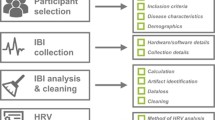Abstract
The assessment of circadian heart patterns represents a new methodology for documenting physiological dysregulation associated with psychiatric illness. Previous research has demonstrated abnormal heart rate patterns, especially during the bedtime interval, that are associated with depression, generalized anxiety disorder, panic disorder, and schizophrenia. These patterns are derived from heart rate data obtained while wearing an unobtrusive, two-lead heart rate monitor over a 24-hour period. To establish basic reliability, the second author blindly rated heart-monitored data from 50 subjects on two occasions, separated by an average of 6.6 weeks (range = 2.9–15.7 weeks). Subjects were classified as “definitely psychiatric,” “probably psychiatric,” “borderline,” “broadly normal,” and “signature normal.” The exact category agreement rate was 78%. If a one-category difference is permitted (e.g., “definitely psychiatric” and “probably psychiatric” counted as an agreement), the agreement rate was 92%. Circadian heart pattern analysis is a promising new technology in psychiatric research and warrants further investigation.
Similar content being viewed by others
REFERENCES
Taylor MA: The Fundamentals of Clinical Neuropsychiatry. New York, Oxford University Press, 1999.
Stampfer HG: The relationship between psychiatric illness and the circadian pattern of heart rate. Australian and New Zealand Journal of Psychiatry 32:298-309, 1998.
Kunz D, Herrmann WM: Sleepwake cycle, sleep-related disturbances, and sleep disorders: A chronobiological approach. Comprehensive Psychiatry 41:104-115, 2000.
Gold PW, Chrousos GP: The endocrinology of melancholic and atypical depression: Relation to neurocircuitry and somatic consequences. Proc Assoc Am Physicians 111:22-34, 1999.
Nemeroff CB: The neurobiology of depression. Scientific American June:42-49, 1998.
Wong ML, Kling MA, Munson PJ, et al: Pronounced and sustained central hyperadrenergic function in major depression with melancholic features: Relation to hypercortisolism and corticotrophin-releasing hormone. Proceedings of National Academy of Sciences (USA) 97:325-330, 2000.
Brawman-Mintzer O, Lydiard RB: Biological basis of generalized anxiety disorder. Journal of Clinical Psychiatry 58 (suppl.):16-25, 1997.
Friedman BH, Thayer JF: Anxiety and autonomic flexibility: A cardiovascular approach. Biological Psychology 49:303-323, 1998.
Thayer JF, Friedman BH, Borkovec TD, et al: Phasic heart period reactions to cued threat and nonthreat stimuli in generalized anxiety disorder. Psychophysiology 37:361-368, 2000.
Stein MB, Asmundson GJG: Autonomic function in panic disorder: Cardiorespiratoty and plasma catecholamine responsivity to multiple challenges of the autonomic nervous system. Biological Psychiatry 36:548-558, 1994.
Sloan RP, Shapiro PA, Bagiella E, et al: Effect of mental stress throughout the day on cardiac autonomic control. Biological Psychology 37:89-99, 1994.
Author information
Authors and Affiliations
Rights and permissions
About this article
Cite this article
Iverson, G.L., Stampfer, H.G. & Gaetz, M. Reliability of Circadian Heart Pattern Analysis in Psychiatry. Psychiatr Q 73, 195–203 (2002). https://doi.org/10.1023/A:1016036704524
Issue Date:
DOI: https://doi.org/10.1023/A:1016036704524




